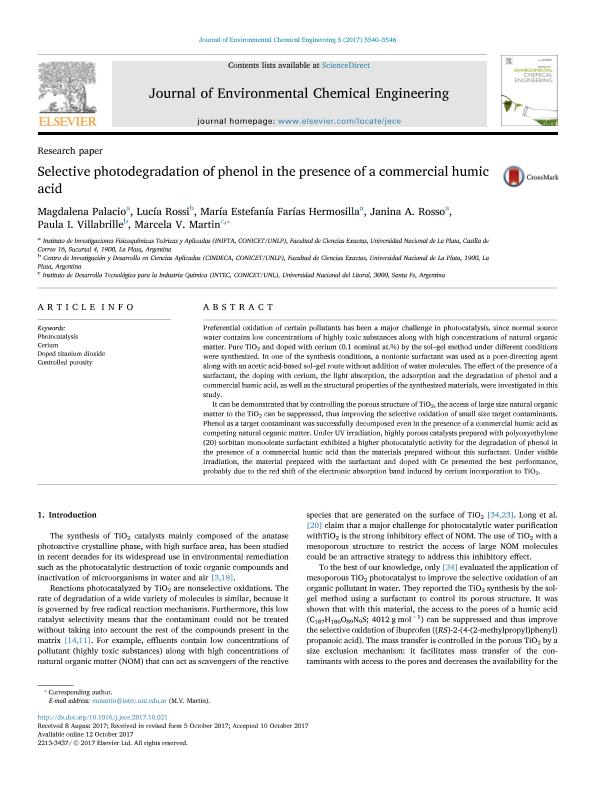Mostrar el registro sencillo del ítem
dc.contributor.author
Palacio, Magdalena

dc.contributor.author
Rossi, Lucia

dc.contributor.author
Farías Hermosilla, María Estefanía

dc.contributor.author
Rosso, Janina Alejandra

dc.contributor.author
Villabrille, Paula Isabel

dc.contributor.author
Martin, Marcela Vanessa

dc.date.available
2018-06-13T17:23:46Z
dc.date.issued
2017-12
dc.identifier.citation
Palacio, Magdalena; Rossi, Lucia; Farías Hermosilla, María Estefanía; Rosso, Janina Alejandra; Villabrille, Paula Isabel; et al.; Selective photodegradation of phenol in the presence of a commercial humic acid; Elsevier; Journal of Environmental Chemical Engineering; 5; 6; 12-2017; 5540-5546
dc.identifier.issn
2213-3437
dc.identifier.uri
http://hdl.handle.net/11336/48533
dc.description.abstract
Preferential oxidation of certain pollutants has been a major challenge in photocatalysis, since normal source water contains low concentrations of highly toxic substances along with high concentrations of natural organic matter. Pure TiO2 and doped with cerium (0.1 nominal at.%) by the sol-gel method under different conditions were synthesized. In one of the synthesis conditions, a nonionic surfactant was used as a pore-directing agent along with an acetic acid-based sol-gel route without addition of water molecules. The effect of the presence of a surfactant, the doping with cerium, the light absorption, the adsorption and the degradation of phenol and a commercial humic acid, as well as the structural properties of the synthesized materials, were investigated in this study. It can be demonstrated that by controlling the porous structure of TiO2, the access of large size natural organic matter to the TiO2 can be suppressed, thus improving the selective oxidation of small size target contaminants. Phenol as a target contaminant was successfully decomposed even in the presence of a commercial humic acid as competing natural organic matter. Under UV irradiation, highly porous catalysts prepared with polyoxyethylene (20) sorbitan monooleate surfactant exhibited a higher photocatalytic activity for the degradation of phenol in the presence of a commercial humic acid than the materials prepared without this surfactant. Under visible irradiation, the material prepared with the surfactant and doped with Ce presented the best performance, probably due to the red shift of the electronic absorption band induced by cerium incorporation to TiO2.
dc.format
application/pdf
dc.language.iso
eng
dc.publisher
Elsevier

dc.rights
info:eu-repo/semantics/openAccess
dc.rights.uri
https://creativecommons.org/licenses/by-nc-nd/2.5/ar/
dc.subject
Cerium
dc.subject
Controlled Porosity
dc.subject
Doped Titanium Dioxide
dc.subject
Photocatalysis
dc.subject.classification
Ingeniería Medioambiental y Geológica, Geotécnicas

dc.subject.classification
Ingeniería del Medio Ambiente

dc.subject.classification
INGENIERÍAS Y TECNOLOGÍAS

dc.title
Selective photodegradation of phenol in the presence of a commercial humic acid
dc.type
info:eu-repo/semantics/article
dc.type
info:ar-repo/semantics/artículo
dc.type
info:eu-repo/semantics/publishedVersion
dc.date.updated
2018-04-16T13:58:06Z
dc.journal.volume
5
dc.journal.number
6
dc.journal.pagination
5540-5546
dc.journal.pais
Países Bajos

dc.journal.ciudad
Amsterdam
dc.description.fil
Fil: Palacio, Magdalena. Consejo Nacional de Investigaciones Científicas y Técnicas. Centro Científico Tecnológico Conicet - La Plata. Instituto de Investigaciones Fisicoquímicas Teóricas y Aplicadas. Universidad Nacional de La Plata. Facultad de Ciencias Exactas. Instituto de Investigaciones Fisicoquímicas Teóricas y Aplicadas; Argentina
dc.description.fil
Fil: Rossi, Lucia. Consejo Nacional de Investigaciones Científicas y Técnicas. Centro Científico Tecnológico Conicet - La Plata. Centro de Investigación y Desarrollo en Ciencias Aplicadas "Dr. Jorge J. Ronco". Universidad Nacional de la Plata. Facultad de Ciencias Exactas. Centro de Investigación y Desarrollo en Ciencias Aplicadas; Argentina
dc.description.fil
Fil: Farías Hermosilla, María Estefanía. Consejo Nacional de Investigaciones Científicas y Técnicas. Centro Científico Tecnológico Conicet - La Plata. Instituto de Investigaciones Fisicoquímicas Teóricas y Aplicadas. Universidad Nacional de La Plata. Facultad de Ciencias Exactas. Instituto de Investigaciones Fisicoquímicas Teóricas y Aplicadas; Argentina
dc.description.fil
Fil: Rosso, Janina Alejandra. Consejo Nacional de Investigaciones Científicas y Técnicas. Centro Científico Tecnológico Conicet - La Plata. Instituto de Investigaciones Fisicoquímicas Teóricas y Aplicadas. Universidad Nacional de La Plata. Facultad de Ciencias Exactas. Instituto de Investigaciones Fisicoquímicas Teóricas y Aplicadas; Argentina
dc.description.fil
Fil: Villabrille, Paula Isabel. Consejo Nacional de Investigaciones Científicas y Técnicas. Centro Científico Tecnológico Conicet - La Plata. Centro de Investigación y Desarrollo en Ciencias Aplicadas "Dr. Jorge J. Ronco". Universidad Nacional de la Plata. Facultad de Ciencias Exactas. Centro de Investigación y Desarrollo en Ciencias Aplicadas; Argentina
dc.description.fil
Fil: Martin, Marcela Vanessa. Consejo Nacional de Investigaciones Científicas y Técnicas. Centro Científico Tecnológico Conicet - Santa Fe. Instituto de Desarrollo Tecnológico para la Industria Química. Universidad Nacional del Litoral. Instituto de Desarrollo Tecnológico para la Industria Química; Argentina
dc.journal.title
Journal of Environmental Chemical Engineering
dc.relation.alternativeid
info:eu-repo/semantics/altIdentifier/doi/https://dx.doi.org/10.1016/j.jece.2017.10.021
dc.relation.alternativeid
info:eu-repo/semantics/altIdentifier/url/https://www.sciencedirect.com/science/article/pii/S2213343717305213
Archivos asociados
